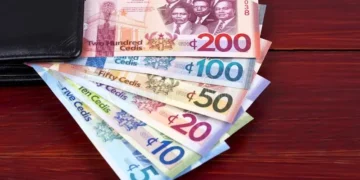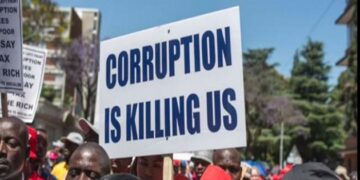On 28 November 2023, Dr Akinwumi A. Adesina, President of the African Development Bank Group, expressed grave concern over Africa’s debt situation while delivering a speech in Nigeria: “Today, Africa’s high debt levels are of great concern. Buoyed by low global interest rates following the 2008 global financial crisis, several African countries rushed to the global capital markets to source cheaper loans to develop their economies, especially to build critically important infrastructure. The Eurobond euphoria saw the number of countries which issued Eurobonds increase from 2 to 21 between 2007 and 2022. They collectively issued $140 billion worth of Eurobonds. Several African countries also rushed to secure cheaper loans from China, as the volume of Chinese loans exploded. Now, the debt load is heavy, as debt service payments have been increasing, as global interest rates rise to tame global inflation. Sub-Saharan Africa’s debt ratio has doubled in just a decade and reached 60% of total GDP in 2022. The region’s ratio of interest payments to revenue has more than doubled since the early 2010s and is now close to four times the ratio in advanced economies: African countries now spend on average 7.6% of their GDP to service debt. Right here, in Nigeria, 98% of government revenue is used to service debt. Africa must find a better and more sustainable way to finance its development. Africa can do this if it manages its natural resources well. That’s because Africa’s natural resources are estimated at $6.5 trillion. Given Africa’s enormous wealth of natural resources, Africa should not be a poor continent. It is high time for Africa to truly assert its aspiration, to move up from being low-income and highly indebted [continent] and become a donor to other less privileged nations”.
Africa is deep in debt and she owes a lot of that to China. According to the Institute for Security Studies, “public debt in Africa surged to a staggering US$1.8 trillion by 2022, representing a 183% increase since 2010. What is even more concerning is that this rate is nearly 300% higher than Africa’s gross domestic product (GDP) growth rate during the same period. As a result, the debt-to-GDP ratio in many African nations is projected to exceed 60% in 2023, signifying a potential imbalance that will make it difficult for governments to manage their financial resources”.
The ISS continued: “China has been a pivotal lender in Africa, extending loans exceeding US$170 billion to 49 African countries and regional institutions between 2000 and 2022”. The ISS’s research found that “while China wasn’t the primary cause of the debt crisis, there were concerns about a lack of transparency, clauses impacting local industries, and the absence of collective restructuring options in Chinese loan contracts”.
Chinese loans, it appears, are a Trojan horse. The ISS paints the picture using Uganda as an example. “Certain elements in Chinese loan contracts can pose significant collateral risks and hinder the financial flexibility of African countries. A case in point is the Entebbe International Airport Upgrading Project. In 2015, the Export-Import Bank of China granted Uganda a US$200 million loan for the project. The airport couldn’t serve as collateral since it is an illiquid asset. Instead, the agreement mandated a cash deposit in an escrow account, allowing the lender to seize it in case of default. The contract also directed all airport revenues towards a 20-year loan repayment, a unique move as the airport predated the loan. Research by the Centre for Global Development found similar clauses in numerous contracts between Chinese lenders and foreign states”.
The China Development Bank and the Export-Import Bank of China are the two institutions behind most of the lending to Africa. Since 2016, however, lending has declined sharply. Just seven loans worth $1.22 billion were signed in 2021. Nine loans totalling $994 million were agreed in 2022, marking the lowest level of Chinese lending since 2004. The China lending explosion seems to have been fuelled by President Xi Jinping’s ambitious Belt and Road Initiative (BRI), launched in 2013 to recreate the ancient Silk Road and extend China’s geopolitical and economic influence through a global infrastructure development push. Also known as the ‘New Silk Road’ project, BRI finances the construction of port, rail and land infrastructure across the globe, mostly in low-income and developing countries in Asia and Africa. The beneficiaries mostly end up in huge debt. At the end of 2021, for example, Statista.com said of the 98 countries for whom data was available, Pakistan ($27.4 billion of external debt to China), Angola (22.0 billion), Ethiopia (7.4 billion), Kenya (7.4 billion) and Sri Lanka (7.2 billion) held the biggest debts to China. It said the countries with the biggest debt burdens in relative terms were Djibouti and Angola, followed by the Maldives and Laos.
China has repeatedly been accused by the West of using debt-trap diplomacy for its forays in Africa. This simply implies that China gives out huge loans to African countries until it chokes them, then the Asian giant moves in to either seize natural sources of the highly indebted countries or make outrageous demands from those countries.
In January 2023, however, China pushed back. Its Foreign Minister Qin Gang refuted the accusation as groundless during a joint press conference with the Chairperson of the African Union (AU) Commission, Moussa Faki Mahamat.
According to the ministry’s website, mfa.gov.cn, Qin Gang noted that African countries have in recent years been actively working to promote economic and social development, but lack of funds has become a major bottleneck to Africa’s prosperity and revitalisation, and how to balance development financing with debt growth is an issue that all countries must face head-on in the course of pursuing development.
Qin Gang said that as good brothers sharing weal and woe, China and Africa have forged ahead side by side on the path of common development. China, the minister noted, has always been committed to helping Africa ease her debt burden, actively participated in the Group of 20 (G20) Debt Service Suspension Initiative, signed agreements or reached consensuses with 19 African countries on debt relief and suspended the most debt service payments among G20 members. He noted that China has also been actively engaged in the case-by-case debt treatment for Chad, Ethiopia and Zambia under the G20 Common Framework.
The website recalled that “President Xi Jinping announced at the Eighth Ministerial Conference of the Forum on China-Africa Cooperation that China would channel to African countries 10 billion U.S. dollars from its share of the International Monetary Fund’s new allocation of Special Drawing Rights, and this work has seen initial progress. Relevant reports from the World Bank have shown that multilateral financial institutions and commercial creditors hold nearly three-quarters of Africa’s total external debt. They take a larger share of Africa’s debt, and they can and should take more robust actions to relieve the debt burden on African countries. China calls upon all parties concerned to contribute to alleviating Africa’s debt burden in line with the principle of common actions and fair burden-sharing”.
Qin Gang emphasised that Africa’s debt problem is essentially an issue of development. The solution to the problem requires addressing not only the symptoms but also the root causes using debt treatment, among others, to enhance Africa’s independent and sustainable development capacity. China’s financing cooperation with Africa is mainly in fields such as infrastructure development and production capacity, to enhance Africa’s capacity for independent and sustainable development.
In his view, the so-called China “debt trap” in Africa is a narrative trap imposed on China and Africa, insisting that projects and cooperation carried out by China in Africa contributed to Africa’s development and the improvement of people’s lives. To him, the African people have the biggest say in this. China, he noted, will continue to respect the will of the African people, and bring tangible benefits to the African people through China-Africa cooperation based on the realities in Africa, to achieve better common development.
For most African countries, China seems to have been a blessing, since they are able to acquire loans from the communist country relatively easily compared to the Bretton Woods institutions – International Monetary Fund and the World Bank as well as other Western countries and lenders – who come to the table with a litany of conditionalities and geopolitical dictates. China, for instance, doesn’t take into consideration, as the West does, a country’s human rights record or political ideology before advancing loans to Africa. The West may see China’s style as “debt-trapping” because they are in a competition of sorts, for the soul of the continent, but is that how Africa sees it? Perhaps, Africa has found a saviour and non-judgemental partner in China and prefers that companionship, no matter the consequences it may portend, to the unfair master-slave and neo-colonialist kind she has endured from the West for centuries.
Debt-trap diplomacy may well be China’s strategy in getting the upper hand in the global scramble for Africa. It is up to Africa to also come to the table with a strategy to avert any devastating future consequences such as losing her natural resources to another sovereign due to high indebtedness. As Adesina warned in his speech, African governments must “stop securing loans backed by their natural resources” since “natural resource-backed loans are non-transparent”. He believes “they are expensive, and they make debt resolution difficult. If the trend continues, it will be a disaster for Africa”. The saddest aspect of these loans, which would be paid by the future generation of Africa, is that a substantial chunk goes into the pockets of corrupt African politicians whose main ambition is to secure power and loot state coffers to build their private empires. There’s nothing wrong with borrowing if the funds are used to build economic and social infrastructure that, in the long run, bolster the economy to not only service and eventually pay off those debts, but also sustain the country while providing better living conditions for the present and future generations.





























